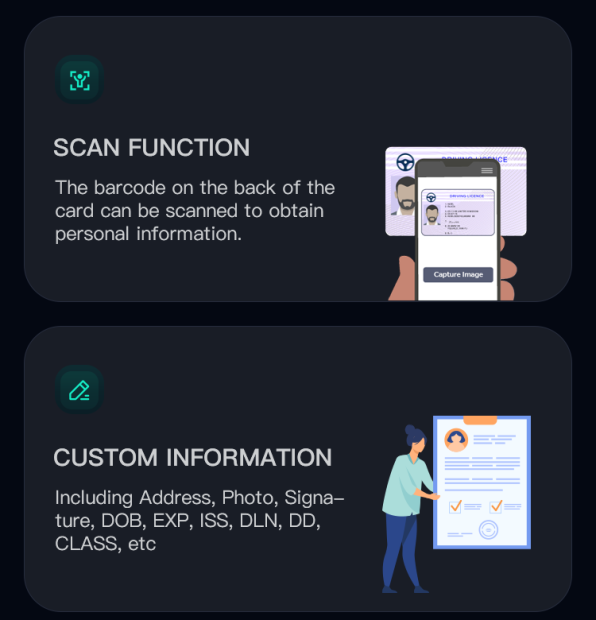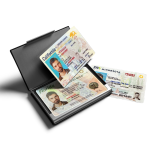The Real ID is a crucial form of identification in the United States. It is a more secure version of the traditional driver’s license or identification card, designed to meet the enhanced security standards set by the Real ID Act of 2005. These standards were put in place to improve the reliability and integrity of identification documents used for official purposes, such as boarding domestic flights and accessing certain federal facilities.
Understanding Humanitarian Parole Status
Humanitarian parole is a temporary permission granted by the U.S. government to an individual to enter the United States for a specific, humanitarian – related reason or significant public benefit. This could include cases where a person has urgent medical needs that can only be addressed in the U.S., or where they are providing essential support to a family member in a dire situation. People with humanitarian parole status are allowed to stay in the U.S. for a limited period, which is usually specified at the time of parole approval.
The Importance of a Real ID for Those with Humanitarian Parole Status
For individuals with humanitarian parole status, having a Real ID can be extremely beneficial. It serves as a recognized and secure form of identification, which can be used for various daily – life activities. For example, it can be used for air travel within the United States. Starting from May 7, 2025, travelers will need a Real ID – compliant document to board domestic flights, so having a Real ID will ensure seamless air travel for those with humanitarian parole.

Moreover, it can also be used to access certain federal facilities, which may be necessary if the individual needs to interact with government agencies for matters related to their parole status or other official business.
The Application Process for a Real ID with Humanitarian Parole Status
1. Gathering Required Documents
The first step in the application process is to gather the necessary documents. These typically include:
- Proof of identity: This could be a valid passport from your home country. If you do not have a passport, other acceptable forms of identity proof may include a foreign birth certificate with a translation (if the original is not in English) and a valid photo ID from your home country or another country you have legally resided in.
- Proof of Social Security number: This can be your Social Security card. If you do not have a Social Security number, you may need to provide a letter from the Social Security Administration stating that you are not eligible for one.
- Proof of residency: You will need to provide two documents that show your current U.S. address. Acceptable documents include utility bills (such as electricity, water, or gas bills), bank statements, or a lease agreement.
- Proof of your humanitarian parole status: This can be the parole approval letter issued by the U.S. government, which contains details such as the start and end dates of your parole, the reason for your parole, and your parolee identification number.
2. Visiting the DMV Office
Once you have gathered all the required documents, you need to visit your local Department of Motor Vehicles (DMV) office. It is advisable to check the DMV’s official website in advance to see if appointments are required. Some DMVs may allow walk – ins, while others may require you to schedule an appointment.
When you arrive at the DMV, you will need to fill out an application form for the Real ID. The form will ask for personal information such as your full name, date of birth, gender, and contact information. You will also need to provide details about your identification documents and your humanitarian parole status.
3. Document Verification
After submitting the application form, a DMV representative will verify the authenticity of your documents. They will check that all the documents are valid, up – to – date, and match the information you provided on the application form. If any of the documents are in a foreign language, they may require a certified translation.

If the DMV representative has any questions or needs further clarification about your documents or your humanitarian parole status, they will ask you at this stage. It is important to be prepared to answer their questions accurately and provide any additional information they may request.
4. Photo and Signature
Once your documents have been verified, you will need to have your photo taken and provide your signature. The photo will be used on your Real ID card, so it is important to follow the DMV’s photo guidelines. These guidelines usually include requirements such as having a neutral expression, no hats or sunglasses, and appropriate lighting.
Your signature will also be recorded, which will be used for verification purposes when you use your Real ID.
5. Paying the Fee
There is a fee associated with applying for a Real ID. The amount of the fee may vary depending on your state and the type of Real ID you are applying for (such as a driver’s license or an identification card). You will need to pay the fee using an acceptable payment method, which may include cash, credit card, or debit card.
6. Receiving the Real ID
After completing all the steps in the application process, you will receive a temporary paper document that serves as your proof of Real ID application. This temporary document can be used in place of the actual Real ID card until you receive it in the mail. The processing time for receiving the Real ID card can vary, but it usually takes a few weeks to a few months. You can check the status of your application on the DMV’s official website or by contacting the DMV directly.
Common Problems and Solutions
1. Missing Documents
Problem: Sometimes, applicants may find that they are missing one or more of the required documents. For example, they may have lost their Social Security card or their foreign birth certificate may be damaged or difficult to obtain a translation for.
Solution: If you are missing your Social Security card, you can apply for a replacement through the Social Security Administration. You will need to provide certain documents, such as proof of identity and citizenship, to obtain a new card. If your foreign birth certificate is damaged or you need a translation, you can contact the appropriate government agency in your home country to request a new copy. You can also hire a certified translator to translate the document if it is in a foreign language. In cases where a document is difficult to obtain, such as if you are from a country with limited government services, you may need to provide additional supporting documents or explain the situation to the DMV.
2. Incomplete Application Form
Problem: Applicants may accidentally leave some fields blank or provide incorrect information on the application form.
Solution: Before submitting the application form, carefully review it to ensure that all fields are filled in correctly. If you realize that you have made a mistake after submitting the form, contact the DMV as soon as possible. They may be able to correct the error for you or guide you on how to make the necessary corrections. In some cases, you may need to submit a new application form if the error is significant.
3. Document Verification Issues
Problem: The DMV may have difficulty verifying the authenticity of some of your documents, especially if they are from a foreign country or if they are in a language other than English.
Solution: If you are using foreign – issued documents, make sure to provide any additional documentation that can help verify their authenticity. For example, if you are using a foreign birth certificate, you can provide a copy of your parents’ passports or other official documents that show your relationship to them. If the documents are in a foreign language, ensure that you have obtained a certified translation. You can also contact the embassy or consulate of your home country in the United States for assistance in verifying the documents. If the DMV has specific questions about a document, be prepared to provide detailed explanations and any additional evidence that you may have.
4. Long Processing Times
Problem: The processing time for receiving a Real ID can be longer than expected, which may cause inconvenience, especially if you need to use the Real ID for an upcoming travel or official matter.
Solution: It is advisable to apply for the Real ID well in advance of when you need it. You can check the estimated processing times on the DMV’s official website and plan accordingly. If you are facing a time – sensitive situation and your Real ID has not arrived yet, you can contact the DMV to inquire about the status of your application. They may be able to provide you with more information or expedite the process if there are valid reasons for doing so, such as an urgent medical need or a pre – scheduled business trip.
5. Language Barriers
Problem: Applicants who are not fluent in English may have difficulty understanding the application process, the requirements, or communicating with the DMV representatives.
Solution: Many DMVs offer language – assistance services. You can inquire about these services when you visit the DMV or check their website in advance. Some DMVs may have multilingual staff, provide translated application forms, or offer interpretation services. You can also bring a translator with you to the DMV appointment to help you communicate effectively. Additionally, there are many online resources available in different languages that can provide information about the Real ID application process, which can help you prepare before visiting the DMV.
Fake ID Pricing
unit price: $109
| Order Quantity | Price Per Card |
|---|---|
| 2-3 | $89 |
| 4-9 | $69 |
| 10+ | $66 |



